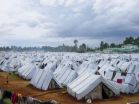(Press-News.org) PROVIDENCE, R.I. [Brown University] — As Kenyan citizens negotiated the tensions following the March 4 nationwide elections, memories of the violence that followed the December 2007 vote weighed heavily for many reasons. Among those in any nation with an HIV epidemic, argue authors of a new paper in AIDS Reviews, should be the long-term damage that political conflict can do to public health by disrupting treatment and thereby promoting resistance to antiretroviral drugs and treatment failure.
"It's the long-term consequences that make this a bigger issue," said lead author Marita Mann, who began studying the rise of drug resistant HIV in the wake of Kenya's 2007 strife when she was a Brown University Master of Public Health student. She is now a doctoral student at the University of Washington. "First there are the patients who are affected themselves during the conflict and may be resistant to treatment later on, but this also may lead to transmitted resistance that will be a bigger problem in the epidemic."
This time around in advance of the elections, Mann said, some Kenya health workers gave their patients extra supplies of medicine and papers that would help them transfer to another clinic in case they were displaced by new violence. In 2007, more than 1,000 Kenyans died and about 300,000 were displaced.
But many policymakers and health officials in HIV- and strife-ridden nations have not recognized the link between disrupted treatment and the potential for increased treatment failure and viral resistance, said senior author Dr. Rami Kantor, associate professor of medicine at Brown University and an infectious diseases physician at The Miriam Hospital in Providence.
The paper seeks to make that link clear by explaining how an unplanned treatment interruption can lead to increased viral drug resistance and treatment failure and by describing the research needed to mitigate the effects of treatment interruption in future conflicts.
The paper provides an overview, but the underlying concern is neither prospective nor hypothetical. In data they have presented at an international HIV conference but not yet published, Mann, Kantor, and colleagues from the AMPATH academic medical collaboration in Kenya found that after the 2007 violence, treatment in subjects whose drug regimens were interrupted by the conflict failed significantly more often than treatment in subjects who did not suffer a conflict-related disruption.
How conflict breeds resistance
HIV mutates often and research shows that as little as a single amino acid change can lead to drug resistance, the authors write. Modern "highly active" antiretroviral therapy (HAART) fights HIV with a potent mix of several drugs that attack the virus in multiple ways, successfully suppressing its replication in most patients.
When violence erupts, staying on those delicately balanced medications can become impossible. Drugs may no longer get to the clinic, patients and health care workers can become displaced, travel to the clinic can become unsafe, and patients can become profoundly depressed by the horror and tragedy around them.
After an unplanned treatment interruption takes place, the multipronged attack of HAART falls apart in an insidious fashion. Some drugs stay in the patient's system longer than others, leaving only a partial therapy in place. That partial therapy fails to stop the virus, instead encouraging the evolution of resistant strains. When full HAART resumes, the virus is better prepared to resist it.
Different variants of the virus will show differences in their likelihood of evolving resistance after an unplanned treatment interruption, the researchers predict.
What can be done
Mann said the steps her colleagues in Kenya took in advance of this year's elections — providing extra medicine and clinic transfer papers — were good ones to take at the level of an individual clinic, assuming they have extra doses of medicine on hand.
Similarly, Kantor said, "In the 2007 conflict AMPATH did a great job to do as much as possible to address the potential issues that we're raising and made great efforts to reach patients to resume care as soon they could, despite the post-conflict displacement and chaos. AMPATH has undertaken similar efforts and preparations for this month's Kenyan elections, including managing treatment stocks, on-call staff, logistical support, and participating in regional and national coordination."
But in the paper, the authors point out that neither health care providers nor officials have much of a rigorous knowledge base to refer to in managing unplanned treatment interruptions. And many officials do not consider or plan for the problem at all.
To better inform and prepare providers and officials, not only in Kenya but in other strife-prone nations with high rates of HIV infection, authors call for further research and attention to planning.
"Research is therefore needed to determine optimal ART stopping and restarting strategies for patients who find themselves in situations of unplanned interruptions," the authors write. "An additional strategy should encompass implementation of contingency treatment plans in developing countries addressing factors like consistent drug supplies, improved patient follow-up, education for healthcare providers, implementation of viral load monitoring and resistance testing and availability of multiple treatment regimens."
And if political leaders and their opponents happen to need one more reason to forgo violence, they can consider how it appears to worsen the HIV pandemic among their constituents.
INFORMATION:
In addition to Mann and Kantor, the paper's other authors are Mark Lurie, assistant professor of epidemiology at Brown, and Dr. Sylvester Kimaiyo at Moi University School of Medicine in Eldoret, Kenya, and program manager of AMPATH.
Kantor, who is research director of the Brown-Kenya program led by Dr. Jane Carter, was supported for this research by a grant from the National Institutes of Health International Epidemiological Databases to Evaluate AIDS program (U01-AI069911); grant R01-AI66922; and the Brown/Lifespan/Tufts Center for AIDS Research (P30-AI042853).
Mann was also supported by the Brown University Framework in Global Health Program. Additional collaborators on this research include Dr. Lameck Diero, Dr. Nathan Buziba, Dr. Wilfred Emonyi, Emmanuel Kemboi, Fidelis Mambo, and Mary Rono from Eldoret, Kenya; Dr. Kara Wools Kaloustian and Dr. John Sidle from Indiana University; Allison DeLong from Brown; and Leeann Schreier, in Kantor's lab.
Political strife undermines HIV treatment
Recent history in Kenya informs research
2013-03-13
ELSE PRESS RELEASES FROM THIS DATE:
Potential early indicator of kidney injury identified
2013-03-13
AUGUSTA, Ga. – A guidance cue that helps kidneys form may also be a red flag that they are in danger, researchers report.
Acute kidney injury, a common and serious complication of hospitalization, is on the increase worldwide, affecting an estimated 6 percent of all hospitalized patients and 30-40 percent of adults and children having cardiopulmonary bypass surgery.
About 10-15 percent of acute injuries translate to chronic kidney damage or failure that may require dialysis or a kidney transplant, said Dr. Ganesan Ramesh, kidney pathologist in the Vascular Biology ...
A European invader outcompetes Canadian plants even outside its usual temperature range
2013-03-13
Dog-strangling vine (Vincetoxicum rossicum) is an exotic plant originating from the Ukraine and southeastern Russia that is becoming increasingly invasive in southern Ontario, Canada. It has been found growing successfully in both disturbed and undisturbed areas, in open fields, forest edges and understories, parks, road edges and railway embankments. The invasive plant effectively competes for light by forming large and dense stands that climb over other plants. A study published in the open access, peer-reviewed journal NeoBiota explores the effects of V. rossicum invasion ...
The natural ecosystems in the Colombian Orinoco Basin are in danger
2013-03-13
The Orinoco River flows from the Andes in Colombia to the Atlantic in Venezuela. The area of the basin includes landscapes of the Andes, plains of the Llanos and the Guiana shield. Orinoco's tributary rivers form a basin considered to be the 3rd most important river system on the planet, and one of the most biologically diverse areas of the world.
Colombia has shown a strong commitment to the achievement of the Convention on Biological Diversity's 2010 biodiversity target, by promoting the conservation of at least 10% of its natural ecosystems. Protected Area categories ...
Astronomers observe planets around another star like never before
2013-03-13
PASADENA, Calif.—Thanks to a new high-tech gadget, astronomers have observed four planets orbiting a star relatively close to the sun in unprecedented detail, revealing the roughly ten-Jupiter-mass planets to be among the most exotic ones known.
The team, which includes several researchers from the California Institute of Technology (Caltech), describes its findings in a paper accepted for publication by the Astrophysical Journal.
The findings were made possible by a first-of-its-kind telescope imaging system that allowed the astronomers to pick out the planets amidst ...
Cancer researchers discover new type of retinoblastoma in babies
2013-03-13
(TORONTO, Canada – March 13, 2013) – A team of Canadian and international cancer researchers led by Dr. Brenda Gallie at the Princess Margaret Cancer Centre, University Health Network (UHN), has discovered a new type of retinoblastoma, a rapidly developing eye cancer that affects very young babies– a finding that can immediately change clinical practice and optimize care for these children.
The finding, published online today in Lancet Oncology, is a breakthrough in recognizing that a single cancer gene (an oncogene) drives an aggressive retinoblastoma that starts long ...
Canadians support interventions to reduce dietary salt
2013-03-13
Philadelphia, PA, March 13, 2013 – Many Canadians are concerned about dietary sodium and welcome government intervention to reduce sodium intake through a variety of measures, including lowering sodium in food, and education and awareness, according to a national survey. The top barriers to limiting sodium intake are a lack of lower sodium packaged and processed foods and lower sodium restaurant menu options.
"Canadians are supportive of government intervention to lower salt intake," says lead investigator Mary R. L'Abbe, PhD, Professor and Chair of the Department of ...
Structured weight loss program helps kids from low-income families lower BMI
2013-03-13
Philadelphia, PA, March 13, 2013 – Overweight and obese children in low-income households can meet or exceed the Expert Committee Recommendations Regarding the Prevention, Assessment, and Treatment of Childhood and Adolescent Overweight and Obesity when given access to a structured weight management program, according to a new study published in Academic Pediatrics.
The epidemic of overweight and obesity in the United States affects children, particularly those in low-income families, where they are at higher risk due to unhealthy diets and consumption of higher calorie, ...
High-performance, NW-OPTs open the way for optoelectronic device miniaturization
2013-03-13
Research team of Ulsan National Institute of Science and Technology (UNIST), Ulsan, South Korea, developed high-performance organic phototransistors (OPTs) based on single-crystalline n-channel organic nanowires.
Phototransistors are a kind of transistors in which the incident light intensity can modulate the charge-carrier density in the channel. Compared with conventional photodiodes, phototransistors enable easier control of light-detection sensitivity without problems such as the noise increment. However, to date, the research has mostly focused on thin-film OPTs, ...
Social networking policies may violate employee rights, NLRB finds
2013-03-13
Social networking policies may violate employee rights, NLRB finds
Article provided by Bryan E. Kuhn, Counselor at Law, P.C.
Visit us at http://www.bryankuhnlaw.com
In the Internet era, social networking sites like Twitter and Facebook have largely replaced the proverbial workplace water cooler. Unlike old-fashioned chatter between coworkers, however, an employee's gripes and grievances can easily become both public and permanent when aired online.
To address this issue, many businesses have sought ways to safeguard their online reputations by creating policies ...
Texas Boy's Forearm Amputated After Washing Machine Accident
2013-03-13
Texas Boy's Forearm Amputated After Washing Machine Accident
Article provided by Portner & Bond, PLLC
Visit us at http://www.portnerbond.com/
An eight-year-old Texas boy wanted his Spider-Man bed sheets, which were in the washing machine. He left his bedroom, went into the garage and opened up the washing machine to take them out; the agitator stopped spinning when he lifted the lid as it was supposed to. But when he reached inside, it started spinning again, according to the El Paso Times. As a result, he lost his forearm.
Defective-Product Lawsuits
Catastrophic ...
LAST 30 PRESS RELEASES:
Making lighter work of calculating fluid and heat flow
Normalizing blood sugar can halve heart attack risk
Lowering blood sugar cuts heart attack risk in people with prediabetes
Study links genetic variants to risk of blinding eye disease in premature infants
Non-opioid ‘pain sponge’ therapy halts cartilage degeneration and relieves chronic pain
AI can pick up cultural values by mimicking how kids learn
China’s ecological redlines offer fast track to 30 x 30 global conservation goal
Invisible indoor threats: emerging household contaminants and their growing risks to human health
Adding antibody treatment to chemo boosts outcomes for children with rare cancer
Germline pathogenic variants among women without a history of breast cancer
Tanning beds triple melanoma risk, potentially causing broad DNA damage
Unique bond identified as key to viral infection speed
Indoor tanning makes youthful skin much older on a genetic level
Mouse model sheds new light on the causes and potential solutions to human GI problems linked to muscular dystrophy
The Journal of Nuclear Medicine ahead-of-print tip sheet: December 12, 2025
Smarter tools for peering into the microscopic world
Applications open for funding to conduct research in the Kinsey Institute archives
Global measure underestimates the severity of food insecurity
Child survivors of critical illness are missing out on timely follow up care
Risk-based vs annual breast cancer screening / the WISDOM randomized clinical trial
University of Toronto launches Electric Vehicle Innovation Ontario to accelerate advanced EV technologies and build Canada’s innovation advantage
Early relapse predicts poor outcomes in aggressive blood cancer
American College of Lifestyle Medicine applauds two CMS models aligned with lifestyle medicine practice and reimbursement
Clinical trial finds cannabis use not a barrier to quitting nicotine vaping
Supplemental nutrition assistance program policies and food insecurity
Switching immune cells to “night mode” could limit damage after a heart attack, study suggests
URI-based Global RIghts Project report spotlights continued troubling trends in worldwide inhumane treatment
Neutrophils are less aggressive at night, explaining why nighttime heart attacks cause less damage than daytime events
Menopausal hormone therapy may not pose breast cancer risk for women with BRCA mutations
Mobile health tool may improve quality of life for adolescent and young adult breast cancer survivors
[Press-News.org] Political strife undermines HIV treatmentRecent history in Kenya informs research




